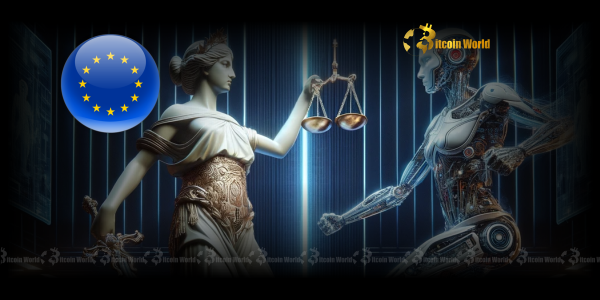EU AI Act: Europe’s Decisive Move on Landmark AI Legislation
0
0
BitcoinWorld

EU AI Act: Europe’s Decisive Move on Landmark AI Legislation
The digital world is constantly evolving, and with it, the regulatory landscape. For those deeply entrenched in the cryptocurrency space, understanding broader technological shifts and their governance is crucial. The recent announcement from the European Union, reaffirming its commitment to the EU AI Act, sends a clear signal across the entire tech ecosystem, including blockchain and Web3. This isn’t just about artificial intelligence; it’s about setting a global precedent for how groundbreaking technologies are managed, impacting everything from data privacy to market access for innovative platforms. Let’s delve into why this decision is a pivotal moment and what it means for the future of tech.
Why is the EU AI Act a Game-Changer for the Digital Landscape?
In a move that underscores its dedication to ethical technological development, the European Union has firmly rejected pleas from over a hundred global tech companies to delay its landmark artificial intelligence legislation. Giants like Alphabet, Meta, Mistral AI, and ASML had collectively urged the European Commission to reconsider the timeline, arguing that strict regulations could stifle Europe’s competitive edge in the rapidly advancing AI arena. However, the EU’s stance remains unwavering. As European Commission spokesperson Thomas Regnier emphatically stated, “There is no stop the clock. There is no grace period. There is no pause.” This definitive declaration ensures that the EU AI Act will proceed as planned, solidifying Europe’s position as a frontrunner in comprehensive digital governance.
The significance of this act extends far beyond just AI developers. It sets a global benchmark for how advanced technologies are regulated, potentially influencing policies in other jurisdictions. For the cryptocurrency sector, where decentralization and innovation often clash with traditional regulatory frameworks, the EU’s approach to AI offers a valuable case study in balancing progress with protection. The Act aims to foster trust in AI systems by ensuring they are human-centric, safe, and compliant with fundamental rights.
Understanding the Core of AI Legislation: What Does It Entail?
The EU’s comprehensive AI legislation adopts a risk-based approach, categorizing AI systems based on their potential to cause harm. This structured framework provides clarity for developers and users alike, ensuring that the level of scrutiny matches the level of risk involved. The Act outlines three primary categories:
- Unacceptable Risk: These are AI systems considered a clear threat to people’s safety, livelihoods, and rights. They are outright banned. Examples include:
- Cognitive behavioral manipulation of individuals or groups.
- Social scoring by governments or public authorities.
- Real-time remote biometric identification in public spaces for law enforcement, with limited exceptions.
- High-Risk: AI systems that pose significant potential harm to health, safety, or fundamental rights. These systems are permitted but subject to stringent obligations before and during their market placement. This category includes AI used in critical sectors such as:
- Biometrics and facial recognition (excluding banned uses).
- Safety components of products (e.g., in medical devices, vehicles).
- Employment, worker management, and access to self-employment (e.g., AI for recruitment, performance evaluation).
- Education and vocational training (e.g., AI for evaluating learning outcomes).
- Critical infrastructure management (e.g., in water, gas, electricity).
- Law enforcement, border control, and administration of justice.
Developers of high-risk AI applications will need to register their systems in an EU database and comply with robust risk and quality management obligations, data governance requirements, human oversight, cybersecurity measures, and transparency rules to gain access to the EU market.
- Limited Risk: AI systems that pose minimal risk but still require transparency to ensure users are aware they are interacting with AI. Examples include chatbots or AI-generated content. These are subject to lighter transparency obligations, such as disclosing that content is AI-generated or that a user is interacting with an AI system.
This tiered approach demonstrates a thoughtful effort to regulate without stifling all innovation, focusing instead on areas where the potential for misuse or harm is greatest. It sets a precedent for how future digital assets and decentralized applications might also be categorized and governed.
How Does AI Regulation Impact Innovation and Development?
The tech industry’s concern about the new AI regulation centers on the potential for increased compliance costs and reduced agility, which they fear could hinder innovation. For startups and smaller companies, navigating complex regulatory frameworks can be particularly challenging, potentially diverting resources from research and development. Some argue that an overly prescriptive approach might push AI innovation out of Europe, towards regions with less stringent rules.
However, proponents of the Act argue that clear regulation fosters trust and provides a stable environment for long-term growth. By establishing clear boundaries and ethical guidelines, the EU aims to create a trustworthy ecosystem for AI development. This could, in turn, attract investment from entities that prioritize ethical and responsible AI. For instance, the Act’s emphasis on data governance and transparency could lead to the development of more robust and auditable AI systems, which aligns with the principles of verifiability often seen in blockchain technologies.
The Act also includes provisions to support innovation, such as regulatory sandboxes and real-world testing environments, which aim to help developers comply with the rules while experimenting with new AI applications. The challenge for both regulators and the industry will be to effectively implement these mechanisms to ensure that the spirit of innovation is preserved alongside the goals of safety and ethical use.
The European Union AI Vision: Balancing Safety and Progress
The vision behind the European Union AI Act is to make Europe a global leader in trustworthy AI. This means developing AI that respects fundamental rights, democratic values, and environmental sustainability, while also promoting economic growth and competitiveness. The EU believes that by setting high standards now, it can shape the future of AI globally and ensure that these powerful technologies serve humanity’s best interests.
This long-term perspective contrasts with the immediate concerns raised by some tech companies about market competitiveness. The EU argues that a strong regulatory framework will ultimately enhance Europe’s attractiveness as a hub for AI development, as businesses and consumers will have greater confidence in the systems being deployed. This commitment to a values-based approach is a defining characteristic of the EU’s digital strategy, evident in previous initiatives like GDPR.
The staggered rollout of the AI Act, which began last year with full implementation expected by mid-2026, provides a phased approach for companies to adapt. This gradual introduction allows businesses to prepare for the comprehensive rules, although the initial pushback indicates that many feel the timeline is still too ambitious given the rapid pace of AI advancements.
What’s Next for the Tech Industry AI Amidst Strict Rules?
The EU’s unwavering commitment means the tech industry AI sector must now pivot from lobbying for delays to focusing on compliance. This will involve significant investment in legal and technical teams to ensure AI systems meet the stringent requirements, especially for those categorized as high-risk. Companies will need to:
- Review and Reclassify: Assess their existing and planned AI applications against the Act’s risk categories.
- Implement Governance Frameworks: Establish robust risk management, quality management, and data governance systems.
- Ensure Transparency: Develop mechanisms for providing clear information to users about AI system capabilities and limitations.
- Invest in Training and Expertise: Upskill internal teams on AI ethics, compliance, and responsible AI development.
- Engage with Regulators: Participate in regulatory sandboxes and pilot programs to understand and influence future interpretations.
While the immediate future might present compliance challenges, the long-term outlook could see a more mature and responsible AI ecosystem emerging from Europe. This could lead to a competitive advantage for European companies that successfully navigate these regulations, as they will be perceived as more trustworthy and ethically aligned. For the broader digital economy, including blockchain and crypto, this regulatory clarity in AI could also pave the way for more defined frameworks in other emerging technologies, fostering an environment of responsible innovation rather than unchecked growth.
The Road Ahead: Navigating the New AI Frontier
The European Union’s firm decision to proceed with its landmark AI legislation on schedule marks a significant moment in the global discourse on technology governance. By prioritizing ethical considerations and user safety through its risk-based approach, the EU is not only shaping the future of AI within its borders but also setting a powerful precedent for the rest of the world. While the tech industry faces the immediate challenge of adapting to these comprehensive rules, the long-term benefits of a trustworthy and transparent AI ecosystem could foster greater public confidence and sustainable innovation.
This unwavering commitment underscores a growing global trend towards regulating powerful emerging technologies. As AI continues to evolve at an unprecedented pace, the lessons learned from the EU AI Act’s implementation will be invaluable for policymakers, businesses, and consumers worldwide, ensuring that the benefits of artificial intelligence are realized responsibly and ethically for all.
To learn more about the latest AI regulation trends, explore our article on key developments shaping AI features and institutional adoption.
This post EU AI Act: Europe’s Decisive Move on Landmark AI Legislation first appeared on BitcoinWorld and is written by Editorial Team
0
0
 Manage all your crypto, NFT and DeFi from one place
Manage all your crypto, NFT and DeFi from one placeSecurely connect the portfolio you’re using to start.




